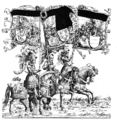
Albrecht Dürer, sometimes spelled in English as Durer, was a German painter, printmaker, and theorist of the German Renaissance. Born in Nuremberg, Dürer established his reputation and influence across Europe in his twenties due to his high-quality woodcut prints. He was in contact with the major Italian artists of his time, including Raphael, Giovanni Bellini, Fra Luca Pacioli and Leonardo da Vinci, and from 1512 was patronized by Emperor Maximilian I.

Albrecht Altdorfer was a German painter, engraver and architect of the Renaissance working in Regensburg, Bavaria. Along with Lucas Cranach the Elder and Wolf Huber he is regarded to be the main representative of the Danube School, setting biblical and historical subjects against landscape backgrounds of expressive colours. He is remarkable as one of the first artists to take an interest in landscape as an independent subject. As an artist also making small intricate engravings he is seen to belong to the Nuremberg Little Masters.

Hans Lützelburger, also known as Hans Franck, was a German blockcutter ("formschneider") for woodcuts, regarded as one of the finest of his day. He cut the blocks but as far as is known was not an artist himself. He is best known for his virtuoso work on 41 of the "superbly cut" series of tiny woodcuts of the Dance of Death, designed by Hans Holbein the Younger, which Lützelburger left unfinished when he died.

The German Renaissance, part of the Northern Renaissance, was a cultural and artistic movement that spread among German thinkers in the 15th and 16th centuries, which developed from the Italian Renaissance. Many areas of the arts and sciences were influenced, notably by the spread of Renaissance humanism to the various German states and principalities. There were many advances made in the fields of architecture, the arts, and the sciences. Germany produced two developments that were to dominate the 16th century all over Europe: printing and the Protestant Reformation.

Hans Burgkmair the Elder (1473–1531) was a German painter and woodcut printmaker.

The doloire or wagoner's axe was a tool and weapon used during the Middle Ages and Renaissance. The axe had a wooden shaft measuring approximately 1.5 metres (5 feet) in length and a head that was pointed at the top and rounded at the bottom, resembling either a teardrop or an isosceles triangle. The top of the shaft was fitted with a metal eye or socket that was welded to the head of the axe near the base of the blade. The upper part of the blade extended above the eye, while the opposite side of the socket featured a small blunt hammer head. The head of the axe itself measured approximately 44 cm. (17 inches) in length, was sharpened on the back and flattened bottom edges, and was uniformly decorated with punched and incised abstract floral patterns.

Trionfo is an Italian word meaning "triumph", also "triumphal procession", and a triumphal car or float in such a procession. The classical triumphal procession for victorious generals and Emperors known as the Roman Triumph was revived for "Entries" by rulers and similar occasions from the Early Renaissance in 14th and 15th-century Italy, and was a major type of festival, celebrated with great extravagance. The cars are shown as open-roofed, many clearly utilitarian four-wheeled carts dressed-up for the occasion. Others were two-wheeled chariots. In art, they might be pulled by all sorts of exotic animals.

Dürer's Rhinoceros is the name commonly given to a woodcut executed by German artist Albrecht Dürer in 1515. Dürer never saw the actual rhinoceros, which was the first living example seen in Europe since Roman times. Instead the image is based on an anonymous written description and brief sketch of an Indian rhinoceros brought to Lisbon in 1515. Later that year, the King of Portugal, Manuel I, sent the animal as a gift for Pope Leo X, but it died in a shipwreck off the coast of Italy. Another live rhinoceros was not seen again in Europe until Abada arrived from India to the court of Sebastian of Portugal in 1577.

The Triumphal Arch is a 16th-century monumental woodcut print commissioned by the Holy Roman Emperor Maximilian I. The composite image was printed on 36 large sheets of paper from 195 separate wood blocks. At 295 × 357 centimetres, it is one of the largest prints ever produced and was intended to be pasted to walls in city halls or the palaces of princes. It is a part of a series of three huge prints created for Maximilian, the others being a Triumphal Procession which is led by a Large Triumphal Carriage ; only the Arch was completed in Maximilian's lifetime and distributed as propaganda, as he intended. Together, this series has been described by art historian Hyatt Mayor as "Maximilian's program of paper grandeur". They stand alongside two published biographical allegories in verse, the Theuerdank and Weisskunig, heavily illustrated with woodcuts.

Hans Springinklee was a German artist from Nuremberg, best known for his woodcuts. He was a pupil of Albrecht Dürer.
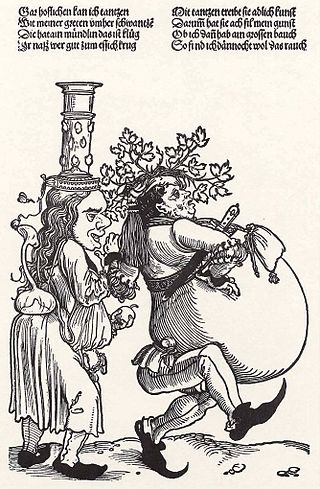
Hans Weiditz the Younger, Hans Weiditz der Jüngere, Hans Weiditz II, was a German Renaissance artist, also known as The Petrarch Master for his woodcuts illustrating Petrarch's De remediis utriusque fortunae, or Remedies for Both Good and Bad Fortune, or Phisicke Against Fortune. He is best known today for his very lively scenes and caricatures of working life and people, many created to illustrate the abstract philosophical maxims of Cicero and Petrarch.
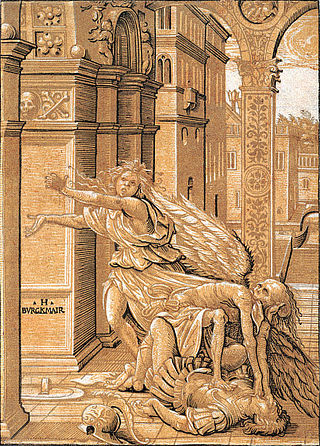
Jost de Negker was a cutter of woodcuts and also a printer and publisher of prints during the early 16th century, mostly in Augsburg, Germany. He was a leading "formschneider" or blockcutter of his day, but always to the design of an artist. He is "closely tied to the evolution of the fine woodcut in Northern Europe". For Adam von Bartsch, although he did not usually design or draw, the quality of his work, along with that of Hans Lützelburger and Hieronymus Andreae, was such that he should be considered as an artist. Some prints where the designer is unknown are described as by de Negker, but it is assumed there was an artist who drew the design, although it has been suggested that de Negker might fill in a landscape background to a drawing of a figure.

Johann, Johannes or Hans Wechtlin was a German Renaissance artist, active between at least 1502 and 1526, whose woodcuts are his only certainly surviving work. He was the most prolific producer of German chiaroscuro woodcuts, printed in two or more colours, during their period in fashion, though most of his output was of book illustrations.

Hieronymus Andreae, or Andreä, or Hieronymus Formschneider, was a German woodblock cutter ("formschneider"), printer, publisher and typographer closely associated with Albrecht Dürer. Andreae's best known achievements include the enormous, 192-block Triumphal Arch woodcut, designed by Dürer for Maximilian I, Holy Roman Emperor, and his design of the characteristic German "blackletter" Fraktur typeface, on which German typefaces were based for several centuries. He was also significant as a printer of music.
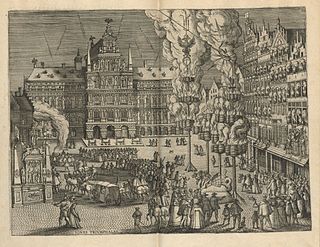
Festival books are books, often illustrated, that commemorate a notable event such as a royal entry, coronation or wedding. Funerals were also commemorated in similar fashion. The genre thrived in Renaissance and early modern Europe, where rulers utilized the form to both document and embellish displays of wealth and power.
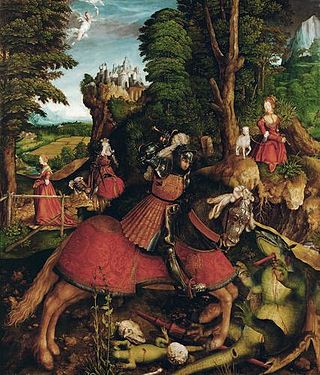
Leonhard Beck was a painter and woodcuts designer in Augsburg, Germany. He was the son of Georg Beck, a miniaturist who was active in Augsburg c. 1490-1512/15. Leonhard collaborated with his father on two psalters for the Augsburg monastery in 1495. He later worked as an assistant to Hans Holbein the Elder, contributing to an altarpiece in 1500-1501 that is now housed in the Städel in Frankfurt am Main.

The Portrait of Emperor Maximilian I is an oil painting by Albrecht Dürer, dating to 1519 and now at the Kunsthistorisches Museum of Vienna, Austria. It portrays the emperor Maximilian I.

The Large Triumphal Carriage or Great Triumphal Car is a large 16th-century woodcut print by Albrecht Dürer, commissioned by the Holy Roman Emperor Maximilian I. The work was originally intended to be the central part of a 54 metres (177 ft) long print of a Triumphal Procession or Triumph of Maximilian, depicting Maximilian and his court entourage in a procession. This section shows the emperor in his triumphal car, and was part of a tradition depicting imaginary "triumphs" or real processions, such as royal entries.

Georg Lemberger was a German painter and woodcut artist.
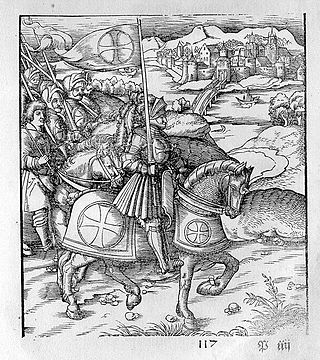
Theuerdank is a poetic work the composition of which is attributed to the Holy Roman Emperor, Maximilian I (1486-1519). Written in German, it tells the fictionalised and romanticised story of Maximilian's journey to marry Mary of Burgundy in 1477. The published poem was accompanied by 118 woodcuts designed by the artists Leonhard Beck, Hans Burgkmair, Hans Schäufelein and others. Its newly designed blackletter typeface was influential.



